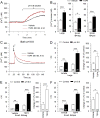Increased thrombospondin-4 after nerve injury mediates disruption of intracellular calcium signaling in primary sensory neurons
- PMID: 28232180
- PMCID: PMC5414309
- DOI: 10.1016/j.neuropharm.2017.02.019
Increased thrombospondin-4 after nerve injury mediates disruption of intracellular calcium signaling in primary sensory neurons
Abstract
Painful nerve injury disrupts Ca2+ signaling in primary sensory neurons by elevating plasma membrane Ca2+-ATPase (PMCA) function and depressing sarco-endoplasmic reticulum Ca2+-ATPase (SERCA) function, which decreases endoplasmic reticulum (ER) Ca2+ stores and stimulates store-operated Ca2+ entry (SOCE). The extracellular matrix glycoprotein thrombospondin-4 (TSP4), which is increased after painful nerve injury, decreases Ca2+ current (ICa) through high-voltage-activated Ca2+ channels and increases ICa through low-voltage-activated Ca2+ channels in dorsal root ganglion neurons, which are events similar to the effect of nerve injury. We therefore examined whether TSP4 plays a critical role in injury-induced disruption of intracellular Ca2+ signaling. We found that TSP4 increases PMCA activity, inhibits SERCA, depletes ER Ca2+ stores, and enhances store-operated Ca2+ influx. Injury-induced changes of SERCA and PMCA function are attenuated in TSP4 knock-out mice. Effects of TSP4 on intracellular Ca2+ signaling are attenuated in voltage-gated Ca2+ channel α2δ1 subunit (Cavα2δ1) conditional knock-out mice and are also Protein Kinase C (PKC) signaling dependent. These findings suggest that TSP4 elevation may contribute to the pathogenesis of chronic pain following nerve injury by disrupting intracellular Ca2+ signaling via interacting with the Cavα2δ1 and the subsequent PKC signaling pathway. Controlling TSP4 mediated intracellular Ca2+ signaling in peripheral sensory neurons may be a target for analgesic drug development for neuropathic pain.
Keywords: Ca(2+) stores and stimulates store-operated Ca(2+) entry; Intracellular calcium signaling; Neuropathic pain; Plasma membrane Ca(2+)-ATPase; Sarco-endoplasmic reticulum Ca(2+)-ATPase; Thrombospondin-4.
Copyright © 2017 Elsevier Ltd. All rights reserved.
Figures











Similar articles
-
Thrombospondin-4 divergently regulates voltage-gated Ca2+ channel subtypes in sensory neurons after nerve injury.Pain. 2016 Sep;157(9):2068-2080. doi: 10.1097/j.pain.0000000000000612. Pain. 2016. PMID: 27168360 Free PMC article.
-
Painful nerve injury decreases sarco-endoplasmic reticulum Ca²⁺-ATPase activity in axotomized sensory neurons.Neuroscience. 2013 Feb 12;231:247-57. doi: 10.1016/j.neuroscience.2012.11.055. Epub 2012 Dec 7. Neuroscience. 2013. PMID: 23219911 Free PMC article.
-
Axotomy depletes intracellular calcium stores in primary sensory neurons.Anesthesiology. 2009 Aug;111(2):381-92. doi: 10.1097/ALN.0b013e3181ae6212. Anesthesiology. 2009. PMID: 19602958 Free PMC article.
-
Privileged coupling between Ca(2+) entry through plasma membrane store-operated Ca(2+) channels and the endoplasmic reticulum Ca(2+) pump.Mol Cell Endocrinol. 2012 Apr 28;353(1-2):37-44. doi: 10.1016/j.mce.2011.08.021. Epub 2011 Aug 24. Mol Cell Endocrinol. 2012. PMID: 21878366 Review.
-
Role of decreased sensory neuron membrane calcium currents in the genesis of neuropathic pain.Croat Med J. 2007 Feb;48(1):9-21. Croat Med J. 2007. PMID: 17309135 Free PMC article. Review.
Cited by
-
The Voltage-Gated Calcium Channel α2δ Subunit in Neuropathic Pain.Mol Neurobiol. 2025 Feb;62(2):2561-2572. doi: 10.1007/s12035-024-04424-w. Epub 2024 Aug 13. Mol Neurobiol. 2025. PMID: 39136907 Review.
-
Does caffeine have a double-edged sword role in inflammation and carcinogenesis in the colon?Intest Res. 2023 Jul;21(3):306-317. doi: 10.5217/ir.2022.00118. Epub 2023 Apr 20. Intest Res. 2023. PMID: 37072923 Free PMC article. Review.
-
Effect of Gabapentin in a Neuropathic Pain Model in Mice Overexpressing Human Wild-Type or Human Mutated Torsin A.Life (Basel). 2021 Jan 12;11(1):41. doi: 10.3390/life11010041. Life (Basel). 2021. PMID: 33445430 Free PMC article.
-
Calcium Imaging of Parvalbumin Neurons in the Dorsal Root Ganglia.eNeuro. 2019 Aug 1;6(4):ENEURO.0349-18.2019. doi: 10.1523/ENEURO.0349-18.2019. Print 2019 Jul/Aug. eNeuro. 2019. PMID: 31311802 Free PMC article.
-
Endoplasmic reticulum-mitochondria interplay in chronic pain: The calcium connection.Mol Pain. 2020 Jan-Dec;16:1744806920946889. doi: 10.1177/1744806920946889. Mol Pain. 2020. PMID: 32787562 Free PMC article. Review.
References
-
- Adams JC. Thrombospondins: multifunctional regulators of cell interactions. Annu Rev Cell Dev Biol. 2001;17:25–51. - PubMed
-
- Budd SL, Nicholls DG. A reevaluation of the role of mitochondria in neuronal Ca2+ homeostasis. J Neurochem. 1996;66:403–411. - PubMed
-
- Catterall WA. Structure and regulation of voltage-gated Ca2+ channels. Annu Rev Cell Dev Biol. 2000;16:521–555. - PubMed
Publication types
MeSH terms
Substances
Grants and funding
LinkOut - more resources
Full Text Sources
Other Literature Sources
Molecular Biology Databases
Miscellaneous

